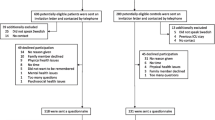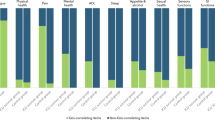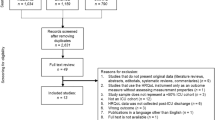Abstract
Objective
a) to examine the EuroQol instrument's ability to assess a patient's state of health prior to admission to an ICU; b) to describe a patient's health-related quality of life (HRQoL) before the onset of the condition leading to admission to the ICU, and prior to discharge; c) to compare patients' preferences for a “common core” of EuroQol health states with preferences from healthy individuals.
Design
Patients in a step-down unit (SDU) retrospectively rated their health states prior to admission to the ICU, their current states of health and the “common core” of hypothetical EuroQol states of health. Proxies rated the patients' health states prior to admission to the ICU. Patients' preferences for EuroQol states of health were compared with the preferences obtained from a retrospective cohort of healthy individuals.
Setting
An SDU at the University Hospital of Bellvitge, Barcelona, Spain.
Patients
103 critical medical and surgical patients were interviewed.
Intervention
The EuroQol questionnaire, a non-disease specific instrument to evaluate HR QoL.
Measurements and main results
Agreement between patients and proxies regarding their prior health state was moderate to good in physical and pain areas (kappa: 0.43–0.58), fair for mood (kappa: 0.38) and almost identical for prior overall health (65.9 vs 66.3). Compared with their prior HRQoL, patients had deteriorated in all physical areas and overall health at discharge from the SDU. Preferences for the worst health states varied significantly between patients and healthy individuals.
Conclusion
The EuroQol can be reliably used with proxies to determine the state of health of patients prior to admission to the ICU. Preferences between healthy individuals and ICU patients differed.
Similar content being viewed by others
References
Thibault GE, Mulley AG, Barnett GO, et al. (1980) Medical intensive care: indications, interventions, and outcomes. N Engl J Med 302: 938–942
Knaus WA, Zimmermann JE, Wagner DP, et al. (1981) APACHE — acute physiology and chronic health evaluation: a physiologically based classification system. Crit Care Med 9: 591–597.
Le Gall JR, Loirat P, Alperovich A, et al. (1984) A simplified acute physiologic score for ICU patients. Crit Care Med 12: 975–977
Lemeshow S, Teres D, Pastides H, et al. (1985) A method for predicting survival and mortality of ICU patients using objectively derived weights. Crit Care Med 13: 519–525
Lemeshow S, Teres D, Avrunin JS, et al. (1987) A comparison of methods to predict mortality of intensive care unit patients. Crit Care Med 15: 715–722
Knaus WA, Drapper EA, Wagner DP, et al. (1985) APACHE II: A severity of disease classification system. Crit Care Med 13: 818–829
Knaus WA, Wagner DP, Draper EA. (1991) The APACHE III prognostic system. Risk prediction of hospital mortality for critically ill hospitalized adults. Chest 100: 1619–1636
Lemeshow S, Teres D, Klar J, et al. (1993) Mortality probability models (MPM II) based on an international cohort of intensive care unit patients. JAMA 270: 2478–2486
Le Gall JR, Lemeshow S, Saulnier F. (1993) A new simplified acute physiology score (SAPS II) based on a European/North American multicenter study. JAMA 270: 2957–2963
Le Gall JR, Brun-Buisson C, Trunet P, et al. (1982) Influence of age, previous health status and severity of acute illness on outcome from intensive care. Crit Care Med 10: 575–578
Patrick DL, Danis M, Sutherland LI, et al. (1988) Quality of life following intensive care. J Gen Intern Med 3: 218–223
Vazquez-Mata G, Rivera R, Gonzalez A, et al. (1992) Factors related to quality of life 12 months after discharge from an intensive care unit. Crit Care Med 20: 1257–1262
Tian ZM, Reis-Miranda D (1995) Quality of life after intensive care with Sickness Impact Profile. Int Care Med 21: 422–428
Goldstein RL, Campion EW, Thibault GE, et al. (1986) Functional outcomes following medical intensive care. Crit Care Med 14: 783–788
Zaren B, Hedstrand U (1987) Quality of life among long-term survivors of intensive care. Crit Care Med 15: 743–747
Jacobs CJ, Van der Vliet JA, Van Roogendaal MT, et al. (1988) Mortality and quality of life after intensive care for critical illness. Intensive Care Med 14: 217–220
Mundt DJ, Gage RW, Lemeshow S, et al. (1989) Intensive care unit patient follow-up. Mortality, functional status and return to work at six months. Arch Inten Med 149: 68–72
Sage WM, Rosenthal MH, Silverman JF (1986) intensive care worth it? An assessment of input and outcome for the critically ill. Crit Care Med 14: 777–782
Yinnon A, Zimran A, Hershko C (1989) Quality of life and survival following intensive medical care. Quarterly J Med 71: 347–357
Sprangers MAG, Aaronson NK (1992) The role of health care providers and significant others in evaluating the quality of life of patients with chronic disease: A review. J Clin Epidemiol 45: 743–760
Magazmier J, Simonsick EM, Kashner M, et al. (1988) Patient-proxy response comparability on measures of patient health and functional status. J Clin Epidemiol 41: 1065–1074
Clarridge BR, Massagli MP (1989) The use of female spouse proxies in common symptom reporting. Med Care 27: 352–366
Danis M, Patrick D, Sutherland LI, et al. (1988) Patients' and families' preferences for medical intensive care. JAMA 260: 797–802
Rosser RM, Kind P (1978) A scale of valuations of states of illness: is there a social consensus? Int J Epidemiol 7: 347–358
Badia X, Fernandez E, Segura A (1995) Influence of socio-demographic and health status variables on evaluation of health states in a Spanish population. Eur J Pub Health 5: 87–93
Brooks RG, Jendteg S, Lindgren B, et al. (1991) EuroQol: health-related quali ty of life measurement. Results of the Swedish questionnaire exercise. Health Policy 18: 37–48
EuroQol Group (1990) EuroQol-a new facility for the measurement of health-related quality of life. Health Policy 16: 199–208
Williams A (1995) The role of the EuroQol instrument in QALY calculations. Discussion paper No. 130. University of York: Centre for Health Economics, 1995
Fleiss JL (1981) The measurement of interrater agreement. In: Fleiss JL (ed) Statistical methods for rates and proportions (2nd edition). Wiley, New York, pp 221–225
Rothman ML, Hedrick SC, Bulcroft KA, et al. (1991) The validity of proxygenerated scores as measures of patient health status. Med Care 29: 115–124
Nord E (1992) Methods for Quality Adjustment of Life Years. Soc Sci Med 34: 559–569
Tsevat J, Cook E, Green M, et al. (1995) Health values of the seriously ill. Ann Intern Med 122: 514–520
Patrick DL, Starks HE, Cain KC et al. (1994) Measuring preferences for health states worse than death. Med Decis Making 14: 9–18
Guadagnoli E, Cleary PD (1995) How consistent is patient reported pre-admission health status when collected during and after hospital stay? Med Care 33: 106–112
Author information
Authors and Affiliations
Rights and permissions
About this article
Cite this article
Badia, X., Díaz-Prieto, A., Rué, M. et al. Measuring health and health state preferences among critically ill patients. Intensive Care Med 22, 1379–1384 (1996). https://doi.org/10.1007/BF01709554
Received:
Accepted:
Issue Date:
DOI: https://doi.org/10.1007/BF01709554




